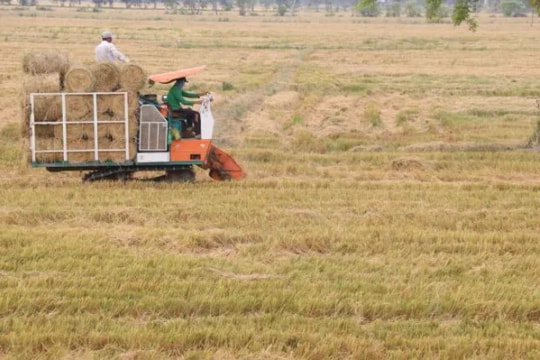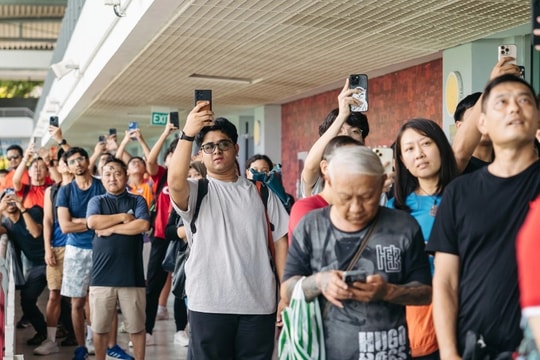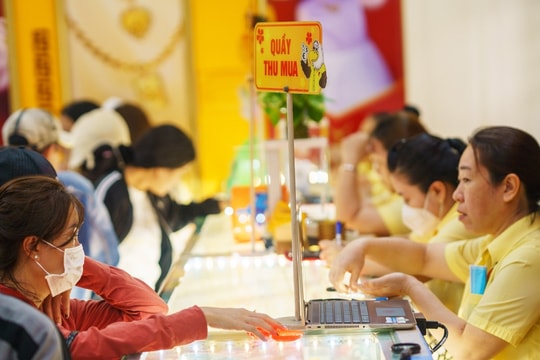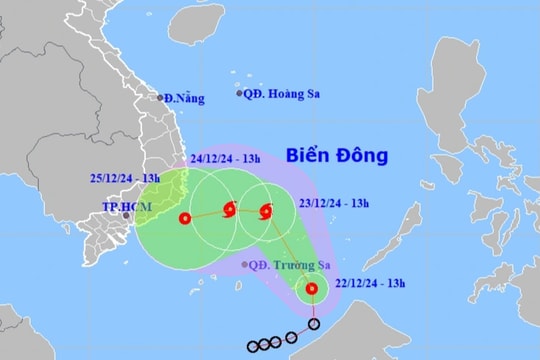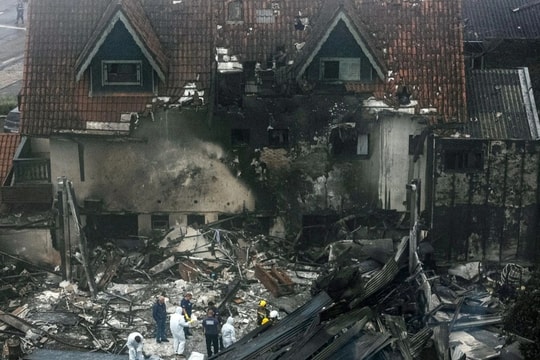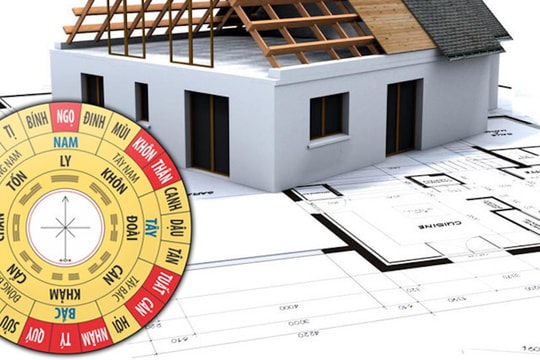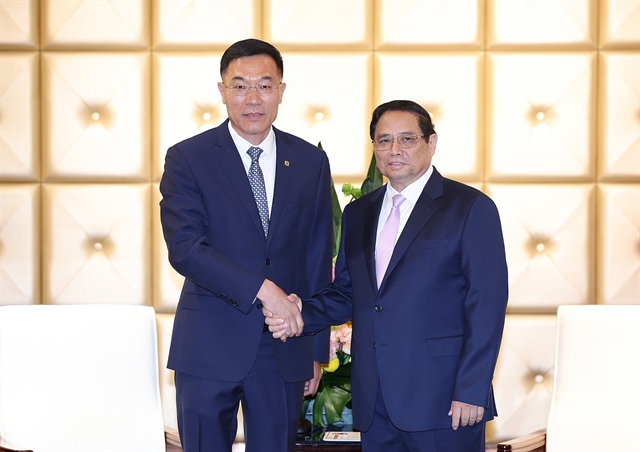 |
| Prime Minister Phạm Minh Chính receives Chairman of the Dalian Locomotive and Rolling Stock Co Ltd (CRRC) Sun Rongkun. VNA/VNS Dương Giang |
Việt Nam is expecting to start a North-South high-speed railway project, which spans over 1,500km, in partnership with China in 2026-27, according to Minister of Transport Nguyễn Văn Thắng.
During a visit to China from June 24-27 for the 15th World Economic Forum in Dalian, China, Prime Minister Phạm Minh Chính also attended a conference on the two countries’ cooperation in transport infrastructure.
He met with leaders of several major Chinese railway corporations, including Sun Rongkun, chairman of the Dalian Locomotive and Rolling Stock Co Ltd (CRRC), and Lou Qiliang, chairman and director general of the China Railway Signal Information Corporation (CRSC).
According to Thắng, the capital needed for Việt Nam’s transportation development until 2045 is huge. The planned 41 expressway routes with a total length of 9,014km require about US$26.09 billion, more than half of which will be mobilised from enterprise capital.
The Ministry of Transport estimated that the national railway network and urban railways in Hà Nội and HCM City require around $208.7 billion.
Việt Nam plans to upgrade and renovate seven existing railway lines with a total length of 2,440km, and build 9 new railway lines with a total length of over 2,600km, including the 175km HCMC-Cần Thơ line and the 1,545km North-South high-speed railway line.
There is also a plan to build 14 urban railway lines in HCM City (6 lines) and Hà Nội (8 lines).
The huge capital needed for those transportation projects is a challenge for the Vietnamese Government, but according to the minister, this is also an investment opportunity for both Vietnamese and Chinese enterprises.
Chairman Sun of the CRRC said his company could meet the demand for building urban railways in Hà Nội and HCM City.
Việt Nam currently has over 2,000km of railways with more than 300 stations, but in recent years their operation has not been truly effective.
PM Chính emphasised the importance of investing in developing railways in Việt Nam, in which investment in urban railways is considered urgent.
With experience in the construction of thousands of kilometres of high-speed railways and metro lines, the PowerChina Group declared its readiness to join Vietnamese partners in realising the goal of building 5,000km of expressways by 2030.
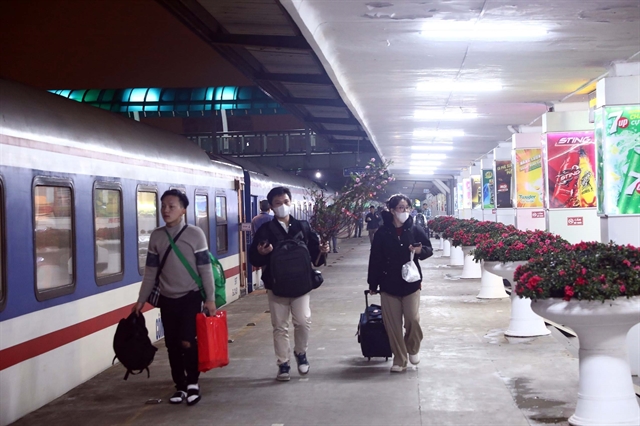 |
| Vietnamese passengers take the north-south railway departing from Hà Nội Station. VNA/VNS Photo Huy Hùng |
At the reception of Chairman Lou of the CRSC, the Vietnamese government leader sought China’s support in accelerating the construction of more than 700km of railways for the three routes: Lào Cai – Hà Nội – Hải Phòng; Lạng Sơn – Hà Nội; and Móng Cái – Hạ Long – Hải Phòng.
The CRSC is a state-owned company and the world’s biggest supplier of rail control systems. It accounts for 45 per cent of China’s subway market.
PM Chính specifically asked for assistance from China in designing, construction and technology transfer of railway lines from China’s Yunnan to Việt Nam’s Hải Phòng City, from Lạng Sơn to Hà Nội, and from China’s Dongxing to Hải Phòng via Móng Cái, which he said were important to Việt Nam. The PM also said Việt Nam wanted to step up urban railway development.
Work on the first project is set to begin next year, connecting China’s Yunnan with the northern province of Lào Cai, Hà Nội and the port city of Hải Phòng.
During the China visit, PM Chính also met Chinese Vice Premier Zhang Guoqing in Beijing, pledging close cooperation in strategic transport connectivity projects of the two countries.
Both sides agreed on the significance of these three railway lines, which will help connect Việt Nam with Central Asia and Europe through China, and connect China with ASEAN via Việt Nam.
China-Laos rail link
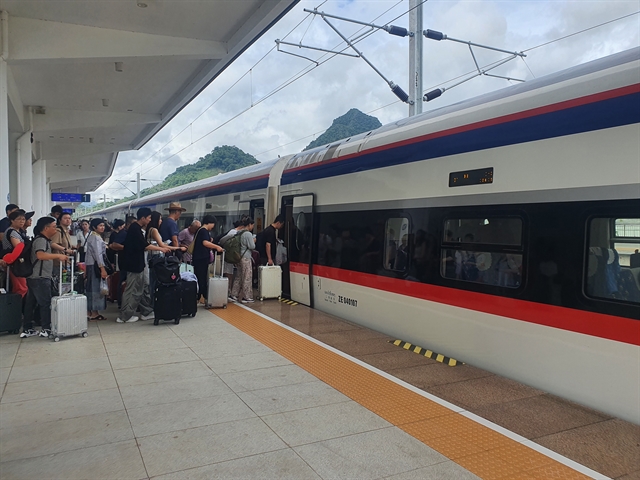 |
| Passengers take cross-border train departing from Vientiane. VNS Photo Lương Hương |
China is renowned for developing a thorough, safe, sustainable, and highly efficient transportation system, including world-class expressways, high-speed rail, airports, and seaports.
The country has expanded cooperation and investment in transportation projects in the region, notably the China-Laos rail link that opened to traffic in 2021.
The line is about 422km in length and was designed for train operations at speeds up to 160km per hour.
The train departs from the Mohan/Boten border checkpoint between the two countries, passing through Luang Namtha, Oudomxay, Luang Prabang, and Vientiane Province before reaching the capital Vientiane.
“The China-Laos Railway has become a golden corridor connecting Southeast Asia with China, Northeast Asia, Central Asia, and even Europe, helping Laos become a land transportation ‘crossroads’ and transportation hub in Southeast Asia,” said Director General of Laos-China Railway Liu Hong.
“With the trial operation of the Laos-Thailand Railway between Bangkok and Vientiane on July 13 and 14, and the future connection of the China-Laos-Thailand rail link with the Malaysian railway, economic and trade cooperation and people-to-people exchanges between ASEAN and China will be promoted, driving the rapid economic development of regional countries. The backbone role of the China-Laos Railway as the main artery of Southeast Asian railways will be further highlighted.”
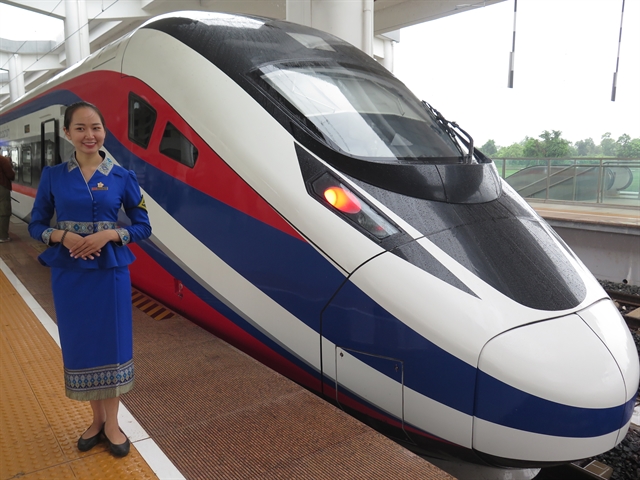 |
| China-Laos Railway connects China’s “Belt and Road” initiative (BRI) with Laos’ strategy to transform from a “land-locked'' to a “land-linked” country. VNS Photo Lương Hương |
The railway’s role as an 'international golden corridor' has earned high praise from the Lao government and widespread acclaim from the people living along the route.
“The Laos-China railway is aimed to become an economic corridor that generates huge income for the nation. It has contributed to the solution of the country’s economic situation by transporting passengers including regional and international tourists, and transporting goods between Laos and China,” said Darany Phommavongsa, minister of Information, Culture and Tourism of Laos.
“Throughout the past year after the opening of the cross-border train service from Vientiane-Kunming (China), it transported 172,023 cross-border passengers starting from April 13, 2023 to the beginning of April 2024.”
The successful service of the China-Laos Railway is seen as a positive example that fuels hopes for similar high-speed rail projects connecting Việt Nam with China and other Southeast Asian nations.
Vietnamese experts expect that the official China visit of Prime Minister Phạm Minh Chính will contribute to accelerating the cooperation programmes between the two countries, particularly in bilateral cooperation on railway development.
“Since the announcement of China's ‘Two Corridors, One Belt’ strategy, the two countries have had agreements to respond to this strategy. Especially after Chinese President Xi Jinping's visit to Việt Nam last year, this strategy has been increasingly mentioned by both sides,” Nguyễn Tăng Nghị, PhD, at the University of Social Sciences and Humanities in HCM City.
“During the recent visit of PM Chính, the leaders of the two countries also emphasised this issue. I believe that based on the ‘Two Corridors, One Belt’ strategy, the two countries will have further cooperation in the development of the railway industry.” VNS
----------------------------
In box:
The Belt and Road Initiative is China's global infrastructure development strategy launched in 2013. It aims to improve regional connectivity and facilitate trade flows across Eurasia and Africa through two main components - the Silk Road Economic Belt linking China to Europe by land, and the 21st Century Maritime Silk Road connecting China's coast to Europe and Africa by sea.




